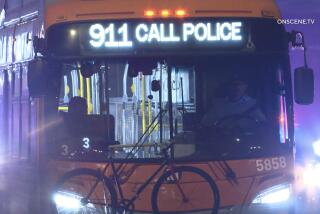12 File Claims in Metrolink Crash
A dozen people, 11 of them survivors of the deadly Glendale railroad crash, filed claims for damages against Metrolink on Wednesday, raising safety questions about the widespread practice of pushing passenger trains from the rear with a locomotive.
A Metrolink commuter train, which had a passenger car in front, on Jan. 26 slammed into a Jeep SUV allegedly left on the tracks by Juan Manuel Alvarez of Compton, who now faces murder charges. The train derailed, killing 11 people and injuring 180.
What Alvarez allegedly did âwas despicable, but the injuries and deaths could have been avoided,â said R. Edward Pfiester Jr., a Los Angeles attorney representing the 12 claimants. âWe feel that Metrolink will continue to use Alvarez as a smoke screen to hide their liability.â
Attorneys for the 12 say Metrolink could have minimized the damage by placing an engine at the front of the train using methods practiced by other commuter railroads. Those include positioning dummy locomotives up front when the âpush-pullâ mode is used, or turning engines and trains around with special track configurations in rail yards or at the end of a line.
Metrolink officials have said those configurations are cost-prohibitive, and also that land might be unavailable for new track.
Agency officials declined Wednesday to discuss the claims, saying they do not comment on pending litigation.A claim for damages is a preliminary step before bringing a lawsuit. If Metrolink denies the claim, the other side is free to take the railroad to court.
The actions were filed by 11 injured passengers and Ann Ormiston of Northridge, the widow of Tom Ormiston, a veteran conductor who was killed in the crash.
The agency and other commuter railroads across the nation have defended push operations, saying the practice has provided hundreds of millions of miles of safe travel since the late 1950s.
Metrolink also contends that the train would not have fared better with a locomotive placed in front.
In the push-pull mode, a train is often propelled from behind but controlled from the front passenger car. When the train heads in the opposite direction, the engine then pulls from the front.
The practice avoids the costly and time-consuming process of turning locomotives around at the end of a line.
Some rail safety experts say cab cars have a greater chance of being damaged in a collision and are more likely to derail. The configuration also puts more people closer to the point of impact.
Since Metrolink began in 1992, 15 passengers have died and more than 300 have been injured in three accidents involving push operations.
Crashes involving locomotives in front, though more numerous, have killed no Metrolink passengers and have injured 25.
More to Read
Sign up for Essential California
The most important California stories and recommendations in your inbox every morning.
You may occasionally receive promotional content from the Los Angeles Times.











